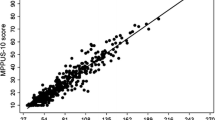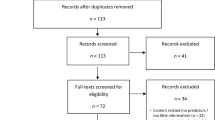Abstract
Objectives
To investigate the associations between problematic mobile phone use and mental health and behavioural problems in 412 Swiss adolescents owning a mobile phone while controlling for amount of mobile phone use.
Methods
Problematic mobile phone use was determined by the MPPUS-10 (Mobile Phone Problem Use Scale) and related to health and behavioural problems by means of multivariable regression modelling.
Results
MPPUS-10 was 4.7 (95 % CI 1.8, 7.6) units higher in girls than in boys, increased significantly with age and was significantly decreased with increasing educational level of the parents. Furthermore, problematic mobile phone use was associated with impaired psychological well-being, impaired parent and school relationships and more behavioural problems but was not related to peer support and social acceptance.
Conclusions
Our study indicates that problematic mobile phone use is associated with external factors such as worse home and school environment and internal factors such as impaired mental health and behavioural problems of the adolescents and thus problematic mobile phone use should be addressed, in particular when dealing with adolescents showing behavioural or emotional problems.
Similar content being viewed by others
References
Augner C, Hacker GW (2012) Associations between problematic mobile phone use and psychological parameters in young adults. Int J Public Health 57:437–441
Aydin D, Feychting M, Schuz J et al (2011) Predictors and overestimation of recalled mobile phone use among children and adolescents. Prog Biophys Mol Biol 107:356–361. doi:10.1016/j.pbiomolbio.2011.08.013
Bianchi A, Phillips JG (2005) Psychological predictors of problem mobile phone use. Cyberpsychol Behav 8:39–51
Billieux J (2012) Problematic use of the mobile phone: a literature review and a pathways model. Curr Psychiatry Rev 8:299–307
Byun YH, Ha M, Kwon HJ et al (2013a) Epidemiological characteristics of mobile phone ownership and use in Korean children and adolescents. Environ Health Toxicol 28:e2013018. doi:10.5620/eht.2013.28.e2013018
Byun YH, Ha M, Kwon HJ et al (2013b) Mobile phone use, blood lead levels, and attention deficit hyperactivity symptoms in children: a longitudinal study. PLoS ONE 8:e59742. doi:10.1371/journal.pone.0059742
Douglas VI (1972) Stop, look and listen: the problem of sustained attention and impulse control in hyperactive and normal children. Can J Behav Sci 4:259
Foerster M, Roser K, Schoeni A, Röösli M (2015) Problematic mobile phone use in adolescents: derivation of a short scale MPPUS-10. Int J Public Health 60:277–286. doi:10.1007/s00038-015-0660-4
Goodman R (1997) The Strengths and Difficulties Questionnaire: a research note. J Child Psychol Psyc 38:581–586
Goodman R (2001) Psychometric properties of the strengths and difficulties questionnaire. J Am Acad Child Adolesc Psychiatry 40:1337–1345. doi:10.1097/00004583-200111000-00015
Ha JH, Chin B, Park D-H, Ryu S-H, Yu J (2008) Characteristics of excessive cellular phone use in Korean adolescents. Cyberpsychol Behav 11:783–784
Ikeda K, Nakamura K (2014) Association between mobile phone use and depressed mood in Japanese adolescents: a cross-sectional study. Environ Health Prev Med 19:187–193. doi:10.1007/s12199-013-0373-3
Inyang I, Benke G, Morrissey J, McKenzie R, Abramson M (2009) How well do adolescents recall use of mobile telephones? Results of a validation study. BMC Med Res Methodol 9:36. doi:10.1186/1471-2288-9-36
Kaess M, Durkee T, Brunner R et al (2014) Pathological Internet use among European adolescents: psychopathology and self-destructive behaviours. Eur Child Adolesc Psychiatry 23:1093–1102. doi:10.1007/s00787-014-0562-7
Klasen H, Woerner W, Rothenberger A, Goodman R (2003) The German version of the Strengths and Difficulties Questionnaire (SDQ-Deu)—overview over first validation and normative studies. Prax Kinderpsychol Kinderpsychiatr 52:491–502
Ko CH, Yen JY, Yen CF, Chen CS, Chen CC (2012) The association between Internet addiction and psychiatric disorder: a review of the literature. Eur Psychiatry 27:1–8. doi:10.1016/j.eurpsy.2010.04.011
Kormas G, Critselis E, Janikian M, Kafetzis D, Tsitsika A (2011) Risk factors and psychosocial characteristics of potential problematic and problematic internet use among adolescents: a cross-sectional study. BMC Public Health 11:595
Lewinsohn PM, Mischel W, Chaplin W, Barton R (1980) Social competence and depression: the role of illusory self-perceptions. J Abnorm Psychol 89:203
Morgan C, Cotten SR (2003) The relationship between Internet activities and depressive symptoms in a sample of college freshmen. Cyberpsychol Behav 6:133–142
Ozturk FO, Ekinci M, Ozturk O, Canan F (2013) The Relationship of Affective Temperament and Emotional-Behavioral Difficulties to Internet Addiction in Turkish Teenagers. Int Sch Res Not 2013
Ravens-Sieberer U, Gosch A, Rajmil L et al (2008) The KIDSCREEN-52 quality of life measure for children and adolescents: psychometric results from a cross-cultural survey in 13 European countries. Value Health 11:645–658. doi:10.1111/j.1524-4733.2007.00291.x
Redmayne M, Smith E, Abramson MJ (2013) The relationship between adolescents’ well-being and their wireless phone use: a cross-sectional study. Environ Health 12:90. doi:10.1186/1476-069x-12-90
Sanchez-Martinez M, Otero A (2009) Factors associated with cell phone use in adolescents in the community of Madrid (Spain). Cyberpsychol Behav 12:131–137
Slater MD (2007) Reinforcing spirals: the mutual influence of media selectivity and media effects and their impact on individual behavior and social identity. Commun Theory 17:281–303. doi:10.1111/j.1468-2885.2007.00296.x
Steinfield C, Ellison NB, Lampe C (2008) Social capital, self-esteem, and use of online social network sites: a longitudinal analysis. J Appl Dev Psychol 29:434–445
Takao M, Takahashi S, Kitamura M (2009) Addictive personality and problematic mobile phone use. Cyberpsychol Behav 12:501–507
The KIDSCREEN Group Europe (2006) The KIDSCREEN Questionnaires—quality of life questionnaires for children and adolescents. In: Handbook Lengerich. Pabst Science Publishers, Germany
Thomée S, Härenstam A, Hagberg M (2011) Mobile phone use and stress, sleep disturbances, and symptoms of depression among young adults-a prospective cohort study. BMC Public Health 11:66
Wartberg L, Aden A, Thomsen M, Thomasius R (2015) Relationships between family interactions and pathological internet use in adolescents: an review. Z Kinder Jugendpsychiatr Psychother 43:9–17. doi:10.1024/1422-4917/a000328 (quiz 18–19)
Willemse I, Waller G, Süss D (2014) JAMES Jugend, Aktivitäten, Medien - Erhebung Schweiz, Factsheet Befunde 2014. Zurich University of Applied Sciences
Yang YS, Yen JY, Ko CH, Cheng CP, Yen CF (2010) The association between problematic cellular phone use and risky behaviors and low self-esteem among Taiwanese adolescents. BMC Public Health 10:217. doi:10.1186/1471-2458-10-217
Yen CF, Tang TC, Yen JY, Lin HC, Huang CF, Liu SC, Ko CH (2009) Symptoms of problematic cellular phone use, functional impairment and its association with depression among adolescents in Southern Taiwan. J Adolesc 32:863–873. doi:10.1016/j.adolescence.2008.10.006
Zheng F, Gao P, He M, Li M, Wang C, Zeng Q, Zhou Z, Yu Z, Zhang L (2014) Association between mobile phone use and inattention in 7102 Chinese adolescents: a population-based cross-sectional study. BMC Public Health 14:1022. doi:10.1186/1471-2458-14-1022
Acknowledgments
The HERMES study is funded by the Swiss National Science Foundation (project number 138190). This research is also supported by the European project GERoNiMO—Generalised EMF Research using Novel Methods—an integrated approach: from research to risk assessment and support to risk management (FP7-ENV-2013, Grant Agreement 603794, 2014–2018). Many thanks go to the study participants and their parents for participating in the HERMES study.
Author information
Authors and Affiliations
Corresponding author
Ethics declarations
Ethical standard
Ethical approval for the conduct of the study was received from the ethical committee of Lucerne, Switzerland on May 9, 2012 (Ref. Nr. EK 12025).
Conflict of interest
The authors declare that they have no conflict of interest.
Electronic supplementary material
Below is the link to the electronic supplementary material.
Rights and permissions
About this article
Cite this article
Roser, K., Schoeni, A., Foerster, M. et al. Problematic mobile phone use of Swiss adolescents: is it linked with mental health or behaviour?. Int J Public Health 61, 307–315 (2016). https://doi.org/10.1007/s00038-015-0751-2
Received:
Revised:
Accepted:
Published:
Issue Date:
DOI: https://doi.org/10.1007/s00038-015-0751-2




